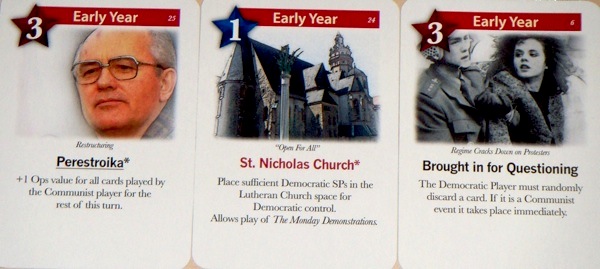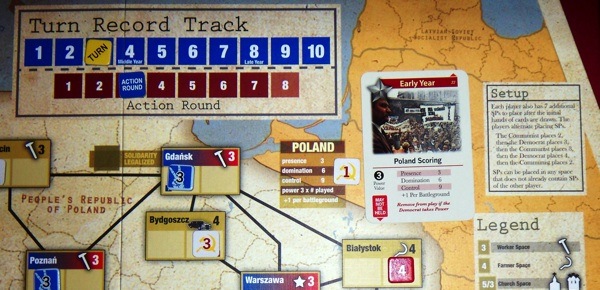1989: Dawn of Freedom – Boardgame Review
 1989: Dawn of Freedom. Boardgame. GMT Games. Designers, Ted Torgerson & Jason Matthews. $65.00
1989: Dawn of Freedom. Boardgame. GMT Games. Designers, Ted Torgerson & Jason Matthews. $65.00
Passed Inspection: Variant of tried-and-true Twilight Struggle system is used particularly well here. Streamlining of some game mechanics help the game to play briskly, and in general, it’s easier to teach the game to new players. Great insights on a recent period of history, with a lot of period flavor. Power Struggle element brings back welcome memories of card-driven games like Hannibal.
Failed Inspection: Because of its tighter focus, 1989 doesn’t have quite the range of Twilight Struggle, and fans of TS may miss Headline Events and blowing up the world (or forcing their opponent to do so). Tiananmen Square track works, but doesn’t quite seem to fit. There are also a few minor quibbles about game tracks and icons.
{default}Any time that a designer, no matter how clever, does a game on a topic that deals with recent history, some folks are going to find themselves uncomfortable with the subject matter, regardless of how well the game may simulate the conflict or period in question. Much of this depends on how controversial or painful the memories are that we associate with the events: for many Americans, Vietnam games have always fallen into this category. As years have passed, however, we find ourselves better able to re-examine those chaotic times, and the gaming industry has begun to catch up.
Leading that charge is one publisher who has never shied away from publishing games on potentially sensitive subjects from our recent past, if they felt the game was a worthy addition to their lineup. GMT Games has won a number of awards for Volko Runke’s Labyrinth: The War on Terror game, and they jump-started the whole modern-war card-driven genre eight years ago with their classic Twilight Struggle, the definitive game on the entire Cold War. (Click here to read Armchair General’s review of Twilight Struggle.)

1989: Dawn of Freedom, which covers the tumultuous events of the fall of Communism in Eastern Europe, is GMT’s latest grand attempt at simulating recent history in an accessible format. 1989 is a direct descendant of Twilight Struggle, and shares most of its parent’s game mechanics. Each turn consists of opponents alternating playing cards; each card is used either for the operational value (which lets you place influence in key cities or attempt to wrest control from your opponent), or for the event depicted on the card. As in TS, if you play a card for Operations that has your opponent’s event, he gets the event for free. This ensures that most of the historical events actually occur during a typical game—which is a good thing, because despite what you might recall regarding this time period, I guarantee you’ll learn something new from playing 1989.
 For every "big picture" topic in 1989 such as Perestroika or Solidarity, there are little-known figures like Jan Palach, who set himself on fire (in 1969!) and some 20 years later, inspired the marches in Prague that were so violently suppressed by the Communist regime. Lech Walesa, Mikhail Gorbachev, President George H.W. Bush visiting Poland, martial law, state-run media, the infamous Stasi secret police, and even the effects of foreign television on Eastern European citizens—all are included and brought vividly to life. You could almost make a mini-game with the variety of cards that deal with the crazy Ceausescu regime in Romania.
For every "big picture" topic in 1989 such as Perestroika or Solidarity, there are little-known figures like Jan Palach, who set himself on fire (in 1969!) and some 20 years later, inspired the marches in Prague that were so violently suppressed by the Communist regime. Lech Walesa, Mikhail Gorbachev, President George H.W. Bush visiting Poland, martial law, state-run media, the infamous Stasi secret police, and even the effects of foreign television on Eastern European citizens—all are included and brought vividly to life. You could almost make a mini-game with the variety of cards that deal with the crazy Ceausescu regime in Romania.
Like all the best historical games, 1989 offers a high degree of historical insight, and wraps it in a wonderfully competitive play package. Part of the reason 1989 is so successful is, of course, the tried-and-true TS game system. Even so, the designers and development team deserve praise for modifying the TS system for this particular conflict in a manner that works particularly well. Gone are the twin avenues of Realignment and Coups from TS; they have been replaced by a single Support Check to try and remove your opponent from a critical space, but the flip side is you get two checks per Operations card instead of one. Moreover, there is no Headline Event phase in 1989, a big change from TS.
The most controversial change from a gameplay standpoint, however, is how the scoring procedure has been changed. Whenever a Scoring card is played in 1989 (for Poland, Czechoslovakia, East Germany, etc.), the Democratic and Communist player must vie for supremacy by playing Power Struggle cards. These are predominately organized into "suits" representing Strikes, Petitions, Marches, and Rallies in the Square, and are supplemented by cards for the various leaders of the Church, Students, Intellectuals, Workers, etc.

The person who played the Scoring card for a country starts by leading off the Power Struggle with any suit, and generally speaking, the other player must match the card from that suit or concede the struggle; anyone who has played, say, Hannibal, will be perfectly at home here. The number of cards each player gets depends on how many cities each controls: The first space controlled grants six Power Struggle cards, and two more for each additional space the player owns in that country. Additionally, each leader card may be played to match any suit, but the catch is that you must own an Elite space in that country to use an Elite leader card, a Worker space for a Worker leader card, and so forth. Finally, there are "wild" cards that let you shut down a suit for that Struggle, draw new cards, and even cause your opponent to discard Power Struggle cards. All in all, a good system that doesn’t add much time to the game, and provides a number of meaningful choices both strategically and tactically. Do I try and get control of the Church space before I play my Scoring card in Hungary, or will that tip my hand to my opponent?
After the Struggle is over, depending on who wins, victory points are scored relative to the importance of the country in question (Poland and East Germany are high, for example). If the Communist remains in power, he gains even more VPs, but if the Communist government falls (which can happen if the Democratic side wins the Power Struggle), then the scoring card for that country is removed from the game! That change alone makes 1989 play very differently from TS, indeed. And it adds immensely to replay value, since the pattern of which country might go out early is not the same from game to game.

Not everything is perfect. The Victory Point Track doesn’t fit well with the rest of the gorgeous map in terms of either palette or placement, and the decision to have Communist VPs listed as negative numbers (including on some event cards) is unnecessarily confusing. And yes, there is a legend on the game board showing that a sickle symbol represents Farmers, while a black limo denotes an Elite space. But why aren’t these icons included on the Power Struggle cards? There is also a Tiananmen Square track that basically allows you to discard one opponent’s event per turn without triggering the event and offers some other advantages. While the struggle in Europe might be part of the overall struggle against totalitarianism, the Tiananmen Square track still takes away from the otherwise laser-like focus of 1989.
But these are, in the end, minor quibbles. Overall, 1989 is a fine example for how to take an existing game system and breathe new life into it. Especially for players new to card-driven strategy games, limiting the Cold War action to Eastern Europe keeps things simple and straightforward; it’s an easy game to wrap your head around, which lets you figure out strategy, rather than fighting the game mechanics. Without the chance of nuclear Armageddon as in TS, and with no Headline Event phase, 1989 is certainly easier to teach; everyone to whom I’ve taught the game has picked it up rapidly, and without exception, had a great time. 1989 is thus one of the rare games that I can enjoy with hardcore strategy/war gamers as well as those folks just looking for a fun game with more than a little bit of interesting, recent history as a bonus. Highly recommended.
Armchair General Rating: 92%
Solitaire Suitability: 2, on a scale of 1–5 with 5 being completely suitable for solitaire play
About the Author

Terry Lee Coleman is former Senior Reviews Editor of Computer Gaming World magazine. He has written about board and card games for several years in such publications as Fire & Movement, The General, Undefeated, and others. While Terry wouldn’t mind having a piece of the Berlin Wall, he will settle for enjoying a good tasty adult Czech beverage every now and then.

